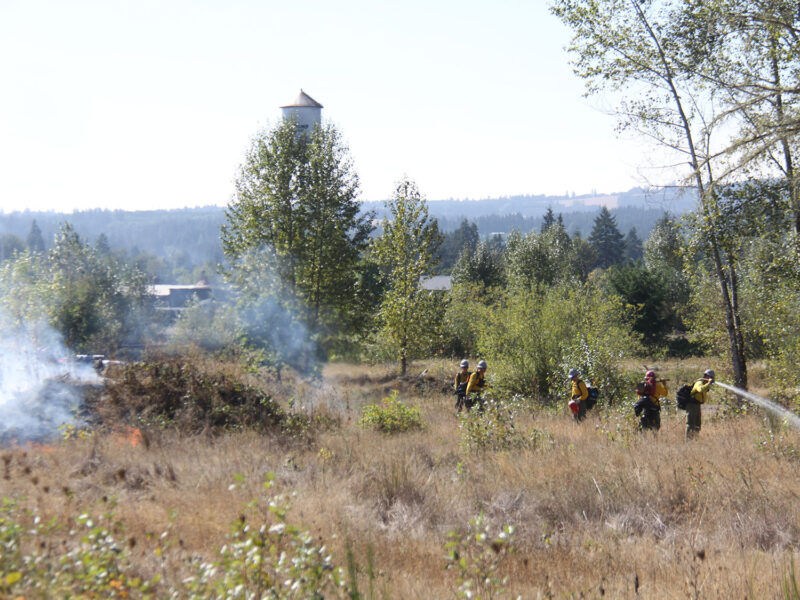Sweet Home Fire and Ambulance District and other firefighting agencies got some really good news last week: $8,711,040 worth of it, to be exact.
The district was alerted that it had received a Community Wildfire Defense grant from the U.S. Forest Service, which goes to communities that have limited resources and face high risk from wildfire.
“It’s pretty amazing,” said Nick Tyler, Sweet Home fire chief.
He said the district has wanted “for quite a while” to be able to apply for the grant, which involved meeting various conditions. Then they had to wait.
“It was many, many, many, months ago that we submitted this,” said Craig Pettinger, unit forester at the Oregon Department of Forestry Sweet Home Unit, who assisted with the application process. He added jokingly, “I almost forgot about it.”
The grants are intended to fund strategic fuels management, increased defensible space work, and expanded resources to help at-risk communities in east Linn County reduce wildfire risk, the U.S. Forest Service said in announcing the grant, one of 10 totaling $57 million, to fund projects across Oregon and Washington, and part of more than $200 million being invested in 58 projects across 22 states and two tribes.
“These grants are about putting resources in the hands of those that know their lands and communities best, so that they can better protect their families, businesses, infrastructure and the future of our shared landscape,” said U.S. Agriculture Secretary Brooke Rollins. “Keeping forests healthy, resilient and productive doesn’t come from the top down, it comes from us standing alongside the people and communities we serve, and supporting practical, science-based management that ensures the future of the forests as well as rural prosperity.”
In total, the program is investing $1 billion over five years to assist at-risk communities, including tribal communities, non-profit organizations, state forestry agencies and Alaska Native Corporations with planning for and mitigating wildfire risks on lands not managed by federal agencies.
“No single organization can tackle the severe fire conditions we face today. It is imperative that we work together to protect our forest and communities,” said U.S. Forest Service Chief Tom Schultz. “For those communities that already have plans in place, these investments will enable immediate action to reduce wildfire risk.”
Tyler and Pettinger noted that the grant doesn’t just benefit Sweet Home.
“I think it’s more going to help the community, a lot of communities in Linn County,” Pettinger said. “ That’s where the work is going to take place.”
Tyler said that a key step toward being able to apply for the grant was to update east Linn County’s Community Wildfire Protection Plan, which is a joint effort by a variety of districts and agencies in east Linn County.
“The last time it was updated was 10 to 15 years ago, so we could never apply,” he said.
He and Pettinger said that changed with the appointment of Christian Whitfield to head Sweet Home’s Wildland Fire Division.
“One of his first priorities was to get the CWPP up and running,” Tyler said of Whitfield. “He got the partners in place and went right to work on the grant.”
“Christian was one who helped seal the deal on this,” Pettinger said.
Tyler said the CWPP is the result of collaboration between SHFAD, which was the lead applicant, the ODF South Cascade District, Lebanon Fire District, Linn County Juvenile Department, and the South Santiam and Calapooia watershed councils.
The updated plan they produced focused on three main strategies:
- “Project Pipeline: Develop a strategic, sustainable and collaborative “project pipeline” that would provide more focused and efficient management and collaboration in reducing dangerous wildfire fuels in the area and fund a community forester to assess and coordinate those efforts. Tyler said a “key” element of the grant is funding a full-time employee who will be responsible for overseeing the joint efforts, “managing, tracking info, figuring out where work needs to be done as we do home assessments.
- Fuels Reduction: Accelerate the pace of fuels reduction by funding a SHFAD fuels crew to treat 60 properties per year, hosting six “Chipper Days” per year for free debris disposal for local residents, and creating defensible space.
- Education and Empowerment: Host seven annual town hall community education events held at Lebanon and Sweet Home stations and substations to equip residents and other community partners with knowledge, decision-making tools and resources to understand and reduce wildfire risks. Establish and support two Firewise Communities, which are neighborhoods that work collaboratively to reduce wildfire risk through various activities, including individual homeowner responsibility for safer home construction and landscaping.
Also, the collaborating agencies will provide education for local K-12 students on fire ecology and prevention, and risk reduction, and will provide vocational training over five years to a total of 285 Linn County Juvenile Department-referred youths relating to careers in fuels and fire.
The project will benefit eight east Linn County communities: Cascadia, Sweet Home, Holley, Crawfordsville, South Lebanon, Sodaville, Waterloo and Lacomb.
“It was kind of an odyssey,” Tyler said of the application process. “There were multiple partners involved, a lot of coordination. One partner backed out late in the cycle.
“Again, having Christian Whitfield involved – he took over as lead for the project.”
Although the funding will benefit east Linn County as a whole, Tyler said $5.4 million of it is earmarked to fund Sweet Home’s Wildland Fire Division.
“There’s a lot of equipment in there as well, to help with the work we’re already doing,” he said of the grant.
Lebanon stands to receive $1 million to hire seasonal wildfire hazard assessment staff and conduct a total of 600 assessments over five years.
Both Tyler and Pettinger pointed out that Sweet Home’s grant was rated second-highest in the nation.
“It’s impressive,” Pettinger said.
He noted that ODF and Sweet Home Fire have already been doing the type of work covered by the grant, but “this is a humongous deal.”
“It will be really interesting to see how it unfolds, how we make all this stuff happen on the ground,” he said.
“I think, honestly, one of reasons we were successful is because we’re all working toward the same goal. It’s impressive.”
Agencies and individuals from throughout the state contributed letters of support for the application, including the Linn County Board of Commissioners, U.S. Forest Service District Ranger Nikki Swanson of the Sweet Home Ranger District, the Linn County Sheriff’s Office, the Oregon State Fire Marshal, the Oregon State University Extension Fire Program, state Rep. Jami Cate of House District 11, the city of Sweet Home, the LinnCounty Parks and Recreation Department, Cascade Timber Consulting, Inc. and residents who have benefited from fuels management work conducted by Linn County Juvenile Department’s workforce training crew.
Tyler noted that a $430,000 grant from the Oregon State Fire Marshal’s Office funded Whitfield’s position, which has resulted in a $5.4 million earlier grant from the U.S. Forest Service to fund the Wildland Division, and now this.
“We took that grant from the Oregon State Fire Marshal’s Office and you can see the fruit of a lot of things we’re doing that couldn’t have been done without that grant,” he said.
“We’re saving taxpayers a lot of money. We’re getting a lot of work done on the backs of these grants we’ve been receiving.
“As fire chief here, it feels really good to be able to get all this work done. I think we’ve created value added in addressing some of these concerns, without cost to taxpayers, without having to pass a bond or levy or that kind of thing.”





